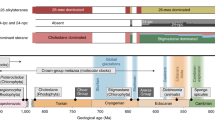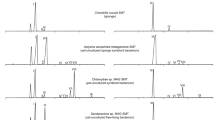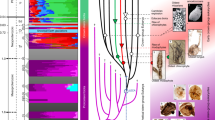Abstract
The earliest fossils of animal-like organisms occur in Ediacaran rocks that are approximately 571 million years old. Yet 24-isopropylcholestanes and other C30 fossil sterol molecules have been suggested to reflect an important ecological role of demosponges as the first abundant animals by the end of the Cryogenian period (>635 million years ago). Here, we demonstrate that C30 24-isopropylcholestane is not diagnostic for sponges and probably formed in Neoproterozoic sediments through the geological methylation of C29 sterols of chlorophyte algae, the dominant eukaryotes at that time. These findings reconcile biomarker evidence with the geological record and revert the oldest evidence for animals back into the latest Ediacaran.
This is a preview of subscription content, access via your institution
Access options
Access Nature and 54 other Nature Portfolio journals
Get Nature+, our best-value online-access subscription
$29.99 / 30 days
cancel any time
Subscribe to this journal
Receive 12 digital issues and online access to articles
$119.00 per year
only $9.92 per issue
Buy this article
- Purchase on Springer Link
- Instant access to full article PDF
Prices may be subject to local taxes which are calculated during checkout

Similar content being viewed by others
Data availability
All data that support the paper are presented in the main text of the manuscript and in the Supplementary Information.
References
Fedonkin, M. A., Simonetta, A. & Ivantsov, A. Y. New data on Kimberella, the Vendian mollusc-like organism (White Sea region, Russia): palaeoecological and evolutionary implications. Geol. Soc. Spec. Publ. 286, 157–179 (2007).
Xiao, S. & Laflamme, M. On the eve of animal radiation: phylogeny, ecology and evolution of the Ediacara biota. Trends Ecol. Evol. 24, 31–40 (2009).
Budd, G. E. & Jensen, S. The origin of the animals and a ‘Savannah’ hypothesis for early bilaterian evolution. Biol. Rev. 92, 446–473 (2017).
Bobrovskiy, I. et al. Ancient steroids establish the Ediacaran fossil Dickinsonia as one of the earliest animals. Science 361, 1246–1249 (2018).
Dunn, F. S., Liu, A. G. & Donoghue, P. C. Ediacaran developmental biology. Biol. Rev. 93, 914–932 (2018).
Parfrey, L. W., Lahr, D. J., Knoll, A. H. & Katz, L. A. Estimating the timing of early eukaryotic diversification with multigene molecular clocks. Proc. Natl Acad. Sci. USA 108, 13624–13629 (2011).
Erwin, D. H. et al. The Cambrian conundrum: early divergence and later ecological success in the early history of animals. Science 334, 1091–1097 (2011).
Dos Reis, M. et al. Uncertainty in the timing of origin of animals and the limits of precision in molecular timescales. Curr. Biol. 25, 2939–2950 (2015).
Dohrmann, M. & Wörheide, G. Dating early animal evolution using phylogenomic data. Sci. Rep. 7, 3599 (2017).
Lozano-Fernandez, J., dos Reis, M., Donoghue, P. C. J. & Pisani, D. RelTime rates collapse to a strict clock when estimating the timeline of animal diversification. Genome Biol. Evol. 9, 1320–1328 (2017).
Cunningham, J. A., Liu, A. G., Bengtson, S. & Donoghue, P. C. The origin of animals: can molecular clocks and the fossil record be reconciled?. Bioessays 39, 1600120 (2017).
Budd, G. E. & Mann, R. P. The dynamics of stem and crown groups. Sci. Adv. 6, eaaz1626 (2020).
Brocks, J. J. & Pearson, A. Building the biomarker tree of life. Rev. Mineral. Geochem. 59, 233–258 (2005).
Volkman, J. K. Sterols and other triterpenoids: source specificity and evolution of biosynthetic pathways. Org. Geochem. 36, 139–159 (2005).
Zumberge, J. A. A Lipid Biomarker Investigation Tracking the Evolution of the Neoproterozoic Marine Biosphere and the Rise of Eukaryotes. PhD thesis, Univ. California Riverside (2019); https://escholarship.org/uc/item/86p25344
McCaffrey, M. A. et al. Paleoenvironmental implications of novel C30 steranes in Precambrian to Cenozoic age petroleum and bitumen. Geochim. Cosmochim. Acta 58, 529–532 (1994).
Zumberge, J. A. et al. Demosponge steroid biomarker 26-methylstigmastane provides evidence for Neoproterozoic animals. Nat. Ecol. Evol. 2, 1709–1714 (2018).
Love, G. D. et al. Fossil steroids record the appearance of Demospongiae during the Cryogenian period. Nature 457, 718–721 (2009).
Love, G. D. et al. Sources of C30 steroid biomarkers in Neoproterozoic–Cambrian rocks and oils. Nat. Ecol. Evol. 4, 34–36 (2020).
Gold, D. A. et al. Sterol and genomic analyses validate the sponge biomarker hypothesis. Proc. Natl Acad. Sci. USA 113, 2684–2689 (2016).
Nettersheim, B. J. et al. Putative sponge biomarkers in unicellular Rhizaria question an early rise of animals. Nat. Ecol. Evol. 3, 577–581 (2019).
Botting, J. P. & Muir, L. A. Early sponge evolution: a review and phylogenetic framework. Palaeoworld 27, 1–29 (2018).
Botting, J. P. & Nettersheim, B. J. Searching for sponge origins. Nat. Ecol. Evol. 2, 1685–1686 (2018).
Antcliffe, J. B. Questioning the evidence of organic compounds called sponge biomarkers. Palaeontology 56, 917–925 (2013).
Grosjean, E. et al. Origin of petroleum in the Neoproterozoic–Cambrian South Oman salt basin. Org. Geochem. 40, 87–110 (2009).
Stolper, D. et al. Paleoecology and paleoceanography of the Athel silicilyte, Ediacaran-Cambrian boundary, Sultanate of Oman. Geobiology 15, 401–426 (2017).
Bhattacharya, S. & Dutta, S. Neoproterozoic-Early Cambrian biota and ancient niche: a synthesis from molecular markers and palynomorphs from Bikaner-Nagaur Basin, western India. Precambrian Res. 266, 361–374 (2015).
Mills, D. B. et al. Oxygen requirements of the earliest animals. Proc. Natl Acad. Sci. USA 111, 4168–4172 (2014).
van Maldegem, L. M. et al. Bisnorgammacerane traces predatory pressure and the persistent rise of algal ecosystems after Snowball Earth. Nat. Commun. 10, 476 (2019).
Hallmann, C. et al. Reply to: Sources of C30 steroid biomarkers in Neoproterozoic–Cambrian rocks and oils. Nat. Ecol. Evol. 4, 37–39 (2020).
Love, G. D. & Summons, R. E. The molecular record of Cryogenian sponges – a response to Antcliffe (2013). Palaeontology 58, 1131–1136 (2015).
Brocks, J. J. et al. The rise of algae in Cryogenian oceans and the emergence of animals. Nature 548, 578–581 (2017).
Hoshino, Y. et al. Cryogenian evolution of stigmasteroid biosynthesis. Sci. Adv. 3, e1700887 (2017).
Bobrovskiy, I., Hope, J. M., Golubkova, E. & Brocks, J. J. Food sources for the Ediacara biota communities. Nat. Commun. 11, 1261 (2020).
Silberfeld, T. et al. A multi-locus time-calibrated phylogeny of the brown algae (Heterokonta, Ochrophyta, Phaeophyceae): investigating the evolutionary nature of the “brown algal crown radiation”. Mol. Phylogenet. Evol. 56, 659–674 (2010).
Knoll, A. H., Summons, R. E., Waldbauer, J. R. & Zumberge, J. E. in Evolution of Primary Producers in the Sea (eds Falkowski, P. & Knoll, A. H.) Ch. 8 (Elsevier Acad. Press, 2007).
Kodner, R. B., Pearson, A., Summons, R. E. & Knoll, A. H. Sterols in red and green algae: quantification, phylogeny, and relevance for the interpretation of geologic steranes. Geobiology 6, 411–420 (2008).
Summons, R. E. & Capon, R. J. Identification and significance of 3β-ethyl steranes in sediments and petroleum. Geochim. Cosmochim. Acta 55, 2391–2395 (1991).
Dahl, J. et al. Extended 3β-alkyl steranes and 3-alkyl triaromatic steroids in crude oils and rock extracts. Geochim. Cosmochim. Acta 59, 3717–3729 (1995).
Kissin, Y. V. Catagenesis and composition of petroleum: origin of n-alkanes and isoalkanes in petroleum crudes. Geochim. Cosmochim. Acta 51, 2445–2457 (1987).
Rushdi, A. I., Ritter, G., Grimalt, J. O. & Simoneit, B. R. T. Hydrous pyrolysis of cholesterol under various conditions. Org. Geochem. 34, 799–812 (2003).
Koopmans, M. P. et al. Diagenetic and catagenetic products of isorenieratene: molecular indicators for photic zone anoxia. Geochim. Cosmochim. Acta 60, 4467–4496 (1996).
Alexander, R., Berwick, L. & Pierce, K. Single carbon surface reactions of 1-octadecene and 2,3,6-trimethylphenol on activated carbon: implications for methane formation in sediments. Org. Geochem. 42, 540–547 (2011).
Volkman, J. K., Barrett, S. M., Dunstan, G. A. & Jeffrey, S. Sterol biomarkers for microalgae from the green algal class Prasinophyceae. Org. Geochem. 21, 1211–1218 (1994).
van Maldegem, L. M. et al. Geological alteration of Precambrian steroids mimics early animal signatures. Nat. Ecol. Evol. https://doi.org/10.1038/s41559-020-01336-5 (2020).
Brocks, J. J. & Hope, J. M. Tailing of chromatographic peaks in GC-MS caused by interaction of halogenated solvents with the ion source. J. Chromatogr. Sci. 52, 471–475 (2014).
Peters, K. E., Walters, C. C. & Moldowan, J. M. The Biomarker Guide. Biomarkers and Isotopes in Petroleum Systems and Earth History 2nd edn, Vol. 2 (Cambridge Univ. Press, 2005).
Acknowledgements
The study was funded by the Australian Research Council grants DP160100607 and DP170100556 (to J.J.B.). I.B. gratefully acknowledges the Texaco Postdoctoral Fellowship. The authors are grateful to L. M. van Maldegem, P. Adam and P. Schaeffer for their helpful feedback.
Author information
Authors and Affiliations
Contributions
I.B. conceived the study, performed the analyses and wrote the first draft. J.M.H. and J.K.V. helped with compound identification. I.B. and B.J.N. interpreted the data. I.B., J.M.H., B.J.N., J.K.V., C.H. and J.J.B. prepared the manuscript.
Corresponding authors
Ethics declarations
Competing interests
The authors declare no competing interests.
Additional information
Publisher’s note Springer Nature remains neutral with regard to jurisdictional claims in published maps and institutional affiliations.
Extended data
Extended Data Fig. 1 Mass spectra of steranes produced via pyrolysis of (iso)fucosterol and saringosterol.
All mass spectra presented in this figure were obtained from one of the S. fusiforme pyrolysates; it was not possible to obtain a pure mass spectrum for βαα 24-npc due to coelution with other compounds.
Supplementary information
Supplementary Information
Supplementary Discussion, Tables 2–4 and references.
Supplementary Table 1
Sterol composition of green algae reported in the literature.
Rights and permissions
About this article
Cite this article
Bobrovskiy, I., Hope, J.M., Nettersheim, B.J. et al. Algal origin of sponge sterane biomarkers negates the oldest evidence for animals in the rock record. Nat Ecol Evol 5, 165–168 (2021). https://doi.org/10.1038/s41559-020-01334-7
Received:
Accepted:
Published:
Issue Date:
DOI: https://doi.org/10.1038/s41559-020-01334-7
This article is cited by
-
Sterol methyltransferases in uncultured bacteria complicate eukaryotic biomarker interpretations
Nature Communications (2023)
-
Sterane and hopane biomarkers capture microbial transformations of complex hydrocarbons in young hydrothermal Guaymas Basin sediments
Communications Earth & Environment (2022)
-
Current understanding on the Cambrian Explosion: questions and answers
PalZ (2021)
-
Geological alteration of Precambrian steroids mimics early animal signatures
Nature Ecology & Evolution (2020)



